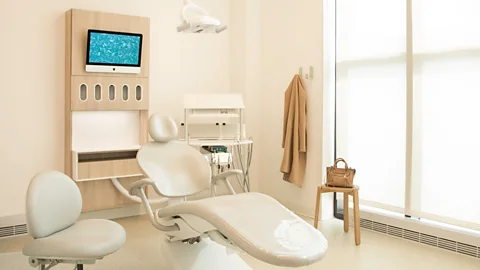Features correspondent
 Courtesy of Tend
Courtesy of TendSeveral companies are entering the American market to disrupt traditional, staid healthcare systems. They see a big opportunity to create change – and make money.
At Cityblock Health’s permanent locations across the US’s mid-Atlantic and Midwest, sleek waiting rooms are outfitted in royal-blue branding. In some cities, the company also deploys mobile units: huge, retrofitted motor caravans painted the same hue. Cityblock Health – which provides medical, mental health and social care – began as part of Sidewalk Labs, Google’s Urban Innovation group, to make healthcare more accessible. Its aesthetic doesn’t feel far from the shiny vibe of its Silicon Valley origins – almost like a hip, urban coffee shop.
It is one of an increasing number of start-ups, both physical and digital, that have come full steam ahead into the American healthcare industry. These businesses aim to transform the face of health services by replacing the staid, sterile and often difficult-to-navigate traditional system with something more inviting and efficient – even spa-like in some cases. While similar companies are popping up globally, there is a singular opportunity in the US, where private insurance is notoriously complex and opaque.
To succeed, these companies aim to address some of the country’s major pain healthcare points – chief among them cost and accessibility. For instance, some make appointment-booking easier, reduce time to see a doctor or even open access to once restricted medical-technology devices. Many of these businesses also work directly with private and government insurers, simplifying the process for patients as a core part of their business strategies.
With this approach, they’re not only trying to break down barriers – they’re also courting a new, younger group of consumers in ways that feel familiar and frictionless. Will it work?
The market opening
Many of these new healthcare players have physical locations with the same curated, minimalist feel and approach across different sectors of care. Dental-franchise Tend has dozens of US storefronts, all designed with warm woods and cool green tiles. They use an app for scheduling and tout transparent pricing. Patients can watch television with noise-cancelling headphones while they get their treatments; then rinse at “The Brushery”, designed for a “selfie moment”, according to Tend. One Medical, a membership-only chain of urgent-care centres, prioritises same-day bookings and has an on-site lab. In February 2023, Amazon completed an all-cash acquisition of the chain for $3.9bn (£3.07bn); then in November, they introduced memberships for Prime subscribers at the discounted annual price of $99 (£78).
 Getty Images
Getty ImagesVirtual start-ups with the same principles are also major players. Their digital aesthetics mimic the minimalism of the brick-and-mortar clinics, and they provide services on modern, uber-functional web platforms. Maven Clinic, a virtual women’s-healthcare platform, was named one of Time magazine’s 100 Most Influential Companies of 2023. BetterHelp, which connects patients directly to mental-health professionals online, crested $1bn (£790m) profits in 2022.
Other companies aim to bring healthcare hardware to the consumer’s home. TytoCare’s thermometer-otoscope-stethoscope device is branded as a “smart clinic”, and sold at national big-box retailer Best Buy. Mosie Baby offers an at-home insemination kit, which sells for $129 (£102), and recently received a stamp of approval from the US Food and Drug Administration (FDA).
There are so many new privately-funded players in the field, says Dan D’Orazio, CEO of healthcare-research and consulting firm Sage Growth Partners, in part because healthcare spending is a massive pie. “If US healthcare was its own country, it would have a GDP of $4.3 trillion. That’d make it the fourth largest in the world,” he says. “There is a truly massive amount of money spent in US healthcare.”
The sticking points of US healthcare provide a clear path for innovation – and, hopefully, profit.
“It’s no secret that people avoid the dentist,” says Helen Zhang, head of communications at Tend. Not only do customers rate the experience low on the net promoter score – which measures customer satisfaction – but it “is known for surprise bills, long wait times, judgemental attitudes from clinicians and inhospitable environments”, she adds. Zhang says Tend’s goal is to not only eliminate the reasons people avoid the dentist, but also provide a visit so comfortable and welcoming that patients see it as a “joyful experience”, and will be inspired to “stop skipping their visits and reprioritize their oral health”.
 Alamy
AlamyPerfect timing
A large part of the proliferation, particularly for the virtual health start-ups, is down to timing. Many of these companies have been around since the 2010s, or even earlier, but with telehealth’s popularity explosion during the pandemic, consumer comfort with and desire for digital services sped up.
“Telemedicine was around for 20 years, maybe longer, but probably had a 2-to-3% adoption rate pre-Covid,” says D’Orazio. “We had not been conditioned to use that kind of care, and patterns are hard to break, so that would have never happened without Covid. What we did in six weeks during Covid would have taken six years for telehealth otherwise.”
Once the barriers to virtual care were down, adds D’Orazio, it became easier for med-tech start-ups to grow, including physical franchises that offer specialised services in aesthetically appealing spaces. And while they cater to patient populations of all ages, D’Orazio says younger generations have been easy adopters.
“A lot of younger folks don’t have a primary-care doctor, and for them it’s not that big a deal,” he says. Telehealth platforms and brick-and-mortar franchises have the appeal of choice, ease and flexibility. The approach is also as nimble as the target audience. Say a patient moves across the country – they can see their same virtual provider agnostic of location, or walk into the same clinic franchise in New York as they did in Los Angeles.
A pathway to success?
An upside of the start-up proliferation, says D’Orazio, is that primary and specialist care has, indeed, become more accessible as hoped. For instance, with walk-in appointments and quick scheduling, many companies have succeeded in reducing the long times – sometimes months – patients often wait for appointments. Their direct coordination with insurance also takes the burden off many patients who normally would have to submit reimbursement paperwork through labyrinthian portals.
Yet D’Orazio also cautions victories like these aren’t necessarily indicative of overall success and viability. Many health tech start-ups, particularly those underpinned by private investment, have failed.
 Getty Images
Getty Images“Why I think a lot of these companies struggle is they’re tech companies, they’re not healthcare companies,” says D’Orazio. “I also think that these disruptors can’t be so naïve to think they’re just going to walk into healthcare, and it’s going to be a walk in the park. There are still regulatory and payment challenges and medical workforce shortages. They don’t get a pass on those issues just because they’re a flashy company.”
He sees a path to increasing viability through a kind of middle ground: collaboration between traditional doctors’ offices and health systems with the medical start-up world. “Integration is really important, and we’re starting to see that with some of these partnerships.”
And while many experts agree the US healthcare is ripe for disruption, the entrance of these start-ups doesn’t spell the end of traditional healthcare as Americans know it. But companies like these may help the overall system make baby steps towards change.
David Dranove, professor of health-industry management at Northwestern University’s Kellogg School of Business, says there’s a lot of room for healthcare to improve – and if even a select few start-ups can find success and help solve some problems, that’s a good thing.
“While not every new idea is going to be good for consumers,” he says, “the status quo is not acceptable. The more we encourage experimentation and encourage new ideas, the more we learn.”
